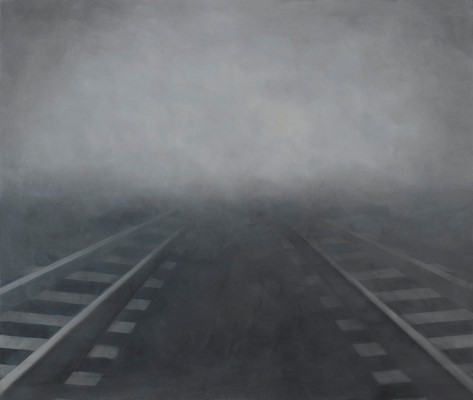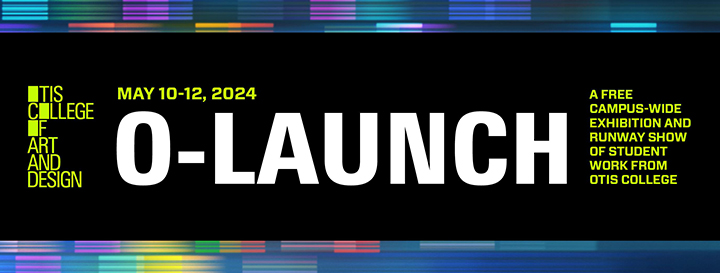
A solo exhibition of new work, “This Happened Here,” by Natalie Arnoldi will open at Charlotte Jackson Fine Art on March 9 and extend through April 2. An Opening Reception with the artist will be held on Friday, March 9 from 5-7 p.m. A Gallery Talk with the artist and Bruce Guenther, author and former Chief Curator of the Portland Art Museum, will be held on Saturday, March 10 from 3-4 p.m.. The gallery is located in the Railyard Arts District at 554 South Guadalupe Street.
A bleak concrete room lit by a single bulb. Empty doorways leading to empty doorways. A corridor, peeling paint, exposed ducts. Pipes, a sealed door. Even without knowing that each of these paintings references a real place – a room within a concentration camp – the quality of the colors, the unexpected mix of sharp and blurred, light and dark, create a visceral reaction. Something happened here.
Natalie Arnoldi grew up in an artist household – a writer mother and artist father (Charles Arnoldi) – a kind of apprenticeship of daily life experience. She grew up studying her father’s decision making process in the studio, talking about art with her parents and their artist friends. Making the decision to pursue science in college and graduate school, focusing on Marine Science and Oceanography, did not separate her from the artistic life, however. She began to paint seriously while still in college. The two tracks, science and art, never seemed to contradict in her world, both are, in her words “creative problem solving.”
Arnoldi’s style, however, is quite different from her father’s minimalist abstraction. She creates intensely emotional and evocative works through the use of ambiguous narrative scenes. Place is key. Early works depict the ocean, waves, undersea views of giant sharks, airplanes in cloudy skies, roads or railroad tracks in the fog, abandoned gas stations at night. Yet while place is so deftly conjured, conversely Arnoldi’s works contain a sort of edgeless, half-told quality. They create a sense of time by suggesting that this slice of a scene is in the midst of evolving or becoming – that something, whether it is a giant shark or a human figure – is about to emerge into this moment. The paintings are simultaneously both startlingly clear and sharp while also containing within them a fogginess – as if bits of the paintings are slipping into or out of focus.
This quality carries over into these new works, based on concentration camp locations. The reaction of a woman to one of her early railroad line paintings keyed Arnoldi into the idea that in addition to eliciting a personal, emotional reaction, her works might also provoke a sense of a particular historical context. Beginning to do research on the holocaust, Arnoldi found herself drawn to images of the camps with their spare, utilitarian, mundane rooms and spaces and the incongruity that they suggested as the sites of such horrific events. As Arnoldi says, “The contradiction of these rooms, which are so mundane in appearance but are the site of heinous acts of cruelty, haunted me. Not only because of what occurred within them, but because as many of the last Holocaust survivors pass away, these places will soon be last physical relic of the largest manifestation of human evil in history.” The time seemed ripe for an exploration of this subject matter which seems to have lost none of its relevance to current events.
Just as in one of Arnoldi’s early paintings – where a shark’s fin, obscured by fog, seems to be disappearing back into oblivion – history, without witnesses to speak and breathe its stories, can become obscured, lost. History can become as sterile as those concrete and metal rooms, robbed of its human relevance. Arnoldi speaks to, and against, this loss, saying “When I visited Auschwitz and Majdanek, the Holocaust became real to me in a visceral and perspective-altering way that studying books and examining photographs could not convey. My hope in creating the paintings is to create a similar experience to witnessing the places in person.”
The very scale of these paintings, mostly larger than body-scale at over 8 feet by 8 ½ feet to as large as 8 ½ by 16 feet, contribute to their visceral effect. These paintings are rooms. Viscerally, the viewer feels in her gut the walls, the press and weight of concrete. Sensations spark alive in the body in response: you can imagine the smell of metal and dust, a slight dampness, the cold of a wall beneath the palm. With their subdued palette of grays and beiges, austere lines, sparse and diffuse lighting, and that unique, quality of ambiguity – these paintings seem to create an experience of history itself – simultaneously disappearing and emerging in a cool, thin light.
For more information about the work of Natalie Arnoldi and “This Happened Here,” running from March 9 to April 2, contact Charlotte Jackson Fine Art at 505-989-8688 or press554@charlottejackson.com.






